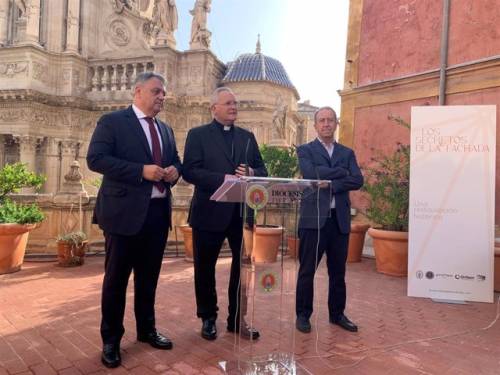
– DIOCESE OF CARTAGENA
The restoration work on the façade of the Cathedral of Murcia will begin on 8 August with a first phase, the placement of the scaffolding, which will last a month and a half, so that by mid-September the restoration work can begin, as announced this Wednesday at a press conference by the Bishop of Cartagena, Monsignor José Manuel Lorca Planes.
The work is valued at more than 1.2 million euros and will take at least 12 months to complete, according to the architect in charge of the project, Juan de Dios de la Hoz, who said that «working on a building like this is a dream for an architect», a project that oscillates between «history, heritage and art, and science».
The work team is made up of more than twenty professionals, specialised in different subjects (architecture, chemistry, geology, history and biology).

The company awarded the contract for the works is Orthem Servicios y Actuaciones Ambientales, one of the eight companies that make up the Hozono Global Group, one of the most important national companies in the field of services and infrastructures.
Orthem has a long track record in the execution of works and management of different types of services in the public and private sector throughout the country. The president of the Hozono Global Group, Manuel Martínez Ortuño, has expressed his gratitude for the trust placed in his company and assures that for them «this restoration goes beyond the mere conservation of a building».
«We will work meticulously, respecting every original detail, to restore the façade to its original splendour and its capacity to tell stories. To do this, we have the best professionals specialised in the restoration of historical heritage,» he says.
The two major fronts of this restoration project are the deterioration caused by water and pigeons. There are some very localised areas on the façade where the water, as it descends, deteriorates the stone, which gradually disintegrates, causing small fragments to break off.
To solve this problem, the water drainage systems will be increased by means of zinc cornices. The other big problem is pigeons and their droppings. With this project, de la Hoz assures that nesting will be eliminated, «perching is more difficult because every centimetre would have to be protected and that would be impossible». Five systems will be used to combat the pigeons, depending on the needs of each area: traps, nets, spikes, electrostatic system and hawks.
The proposed intervention consists of protecting each and every one of the elements that make up the façade, whether sculptural or architectural.
This includes general cleaning, repair and protection of the cornices; the application of lime water consolidants; the restoration of deteriorated elements; the repair of balustrades; and the cleaning and protection of the stained glass windows, as well as various systems to prevent pigeons from nesting as they do at present. Some lighting installations will also be included, as well as others to facilitate future maintenance tasks.
The façade has a surface area of almost 1,000 m2 if measured flat, but this figure increases exponentially given the enormous decorative and formal richness of the façade, with projecting cornices, pediments, doorways, recesses and niches, among others. The work is complete, so the scaffolding must be placed over the entire surface of the façade and the work will be carried out in its entirety.
Previously, a series of works and studies have been commissioned, which have served as a basis for making decisions in the technical project. Thanks to this, it has been possible to identify the different stone typologies, as well as possible historical quarries, in addition to testing the behaviour of all the materials to ensure their suitability and that they do not damage the monument in any way.
Several historical quarries have been studied, mainly thanks to the writings of Elías Hernández Albadalejo, with satisfactory results in four of them, as there is a high degree of similarity between their petrographic and physical characteristics: the Mayayo Quarry, south of the city of Murcia (with three quarry fronts); the Los Garres Quarry, southeast of the capital (with two fronts); the Cuello de Tinajas Quarry, south of the city of Murcia; and the El Partidor Quarry in Abanilla.
GRANTS TO FINANCE THE WORK
The total cost of the restoration of the Cathedral’s façade amounts to 1.2 million euros. In order to meet this cost, the bishop assured that a loan will be requested, as well as the collaboration of the public administration and companies in the Region of Murcia.
He also recalled that a year ago a Bizum (‘04574’) was made available to citizens to collaborate with this project.
«The Cathedral of Murcia is the greatest emblem of the Region», according to the bishop, which is why he wants to involve the whole of Murcia society in this event. To this end, on 26 July, the Parrandboleros will perform a concert, with free admission, in the Plaza del Cardenal Belluga, at 21.30.
GUIDED TOURS TO DISCOVER THE SECRETS OF THE FAÇADE
The restoration will allow all Murcians and tourists to see the sculptures and details of the façade up close and learn the secrets of the façade.
This unique opportunity will be made possible thanks to the erection of double scaffolding that will allow visitors to visit during the course of the works without interfering with them. Guided tours with reduced seating capacity will allow visitors to get a close-up view of the work being carried out on the main elements of the façade.
In addition, people with reduced mobility and blind people will be able to participate in the visit in a different way in the interpretation centre that will be set up in a room of the Episcopal Palace with access from the square.
All the information about when these visits will begin and how tickets can be booked can be consulted on the website ‘lossecretosdelafachada.com‘.
